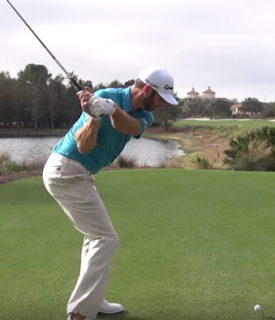|
|
Post by Richie3Jack on Jun 25, 2015 14:56:19 GMT -5
I wanted to get into this as I think some people are interested. About a year ago, here was a video of my golf swing:
This was a bit of M.O.R.A.D. with then some Zenolink stuff thrown in. It was generating about 105 mph club speed with the driver and producing a +3 degree attack angle.
There were a lot of pieces here that were not where I wanted them to be. P2 is a bit off and the left shoulder gets too high, too soon (by M.O.R.A.D standards).
When looking at it from the Miyahira standpoint, there is way too much Left Pelvic Tilt going back and not enough right side load in the backswing. There is a lack of left hip internal rotation in the back swing as well.
On the downswing, the sacrum slides and there is no Anterior Pelvic Tilt. The left knee kicks out towards the target, essentially 'starting from the ground up' instead of starting the downswing by 'moving the middle.' Because I'm sliding and do not have dual ER of the hips, I have no shot of rotating the pelvic and lose the tush line. I'm also pushing off the ball of my left foot instead of rotating and eventually getting Posterior Pelvic Tilt. And the left shoulder eventually starts to externally rotate causing a flip-roll release.
A big issue is that I didn't have good practice habits when it comes to learning new movement patterns. That would have helped me at least achieve the mechanics prescribed.
And even still, I was hitting the ball quite good last year. I played in the FSGA Mid-Am and shot 78-73 and finished 31st out of 135 golfers. And I struck the ball the worst I had all season up until that point at that tournament.
***
While I was striking the ball well and shot 78-73 with a respectable finish at the Mid-Am; the main point was the troubles I had with my ballstriking at the Mid-Am. For starters, I still have a goal of playing in qualifying for the US Amateur some day. And I realized two major issues:
1. Swinging at 105 mph with the driver is going to be a long shot to qualify for the US Amateur because you're going to have to have a great day putting. Especially when you look at the qualifiers in Florida where the sites like Orange County National and Ocala National a bomber can bomb it until their heart is content. I think a lot of people would be surprised to learn that college players don't swing nearly as fast as they think, usually around 110 mph. But, it's still a big difference between 105 and 110 mph and on Florida sites you usually see long hitters win.
2. Once again my swing fell apart in competition. Not only is it a problem, but it's just flat-out annoying and depressing when you strike it well almost every day leading up to an event and your swing collapses on you.
I wanted to try working with Kelvin Miyahira on my swing for several reasons. The big key ones were his ability to improve his students' club head speeds by impressive amounts. The other is how his students could increase that speed and better stabilize the club head (aka slow the rate of closure).
While it's true that we rate of closure study is in its infancy stage, I just know that most of the best and most consistent ballstrikers have slow rate of closures. Don't worry, a slow rate of closure won't mean 'more hooks!' The face is still closing (why it's called 'rate of CLOSURE') so the gear effect is still in action. It just means that your spin axis won't tilt as much to the slice side.
One case of Kelvin's brilliant work is with Lucas Wald. As you can see, the transformations in Lucas' swing, going from 108 mph to 120 mph...for a former Arkansas State Open champion are quite remarkable.
But the other thing that drew me into Kelvin's work is the transformation that Grant Hooper made with his swing. Grant actually never took a lesson from Kelvin. He just studied Kelvin's articles, practiced and asked questions on Jeffy's forum:
Grant went from roughly 100 mph to 122 mph (when he's practicing consistently).
Both are impressive case studies because it is more difficult to make that drastic of a change for adults than it is children. In Lucas' case, he's more apt to stick with old habits because he was such a good player beforehand and his brain is going to tell him to do what he has been doing for years and what has worked for him. In Grant's case, he was not near the caliber of player as Lucas, but his brain doesn't really know any better and the concepts were likely to be very foreign to him when he was practicing.
*** I won't be showing any videos of my swing until I think it's pretty close to being ready. However, I know that about 4-weeks ago I got on Trackman and was at 112.1 mph with the driver on 8 swings with a max of 114.1 mph. Then last week, I was on Trackman again (this time indoors) and was at 111.1 mph average with a max of 112.9 mph. I was working on some new pieces of the swing the 2nd time around and I hating hitting into nets. Anyway, we'll call it 111.6 mph club speed. One of the main reasons why I will not show a video of my swing is simply because I haven't used video in a long, long time. I think it's been close to 3 months since I last used video. My practice methodology has changed. I still prescribe using video to people, but changing my practice methodology and NOT using video has helped me because I've focused more on what I need to work on based on how it FEELS like I'm swinging and the ball flight it is producing. I'll work on something for a few weeks and then move on to new pieces. I can STILL work on those things I just came off focusing on, but they are no longer my main focus. Part of the issue with using video FOR ME is that I start to see things I don't like and want to change too many things and at the wrong time. I still think video is important I would not be interested in working with an instructor that will not use video. But, there's a time and place to use it when you're practicing by yourself. The main issue I'm working to cure now is the under-flip. Here's an extreme example of an underflip (obviously on a pitch shot)  In TGM terms, it's when the club head 'overtakes' the hands thru impact. This increases the dynamic loft of the club. And as I saw on Trackman last week, despite having a +1.8 degree upward AoA, my spin rates were quite high. Why? Because the underflip causes you to increase the dynamic loft which increases the Spin Loft. Furthermore, you're more likely to hit below the CoG of the club and the vertical gear effect kicks in and causes the ball to spin more. Part of the other issue is I'm trying to get rid of right pelvic tilt on the downswing. Once you understand right pelvic tilt and if you in particular had RPT in your swing and got rid of it, you should become convinced that RPT is a destroyer of great golf swings. But my key focus at this current time is keeping my left shoulder internally rotated and my right shoulder externally rotated for as long as I can on the downswing. If you do this you can make it more easier to stabilize the clubface, not only from an underflip perspective, but a rolling perspective as well. I think that is what Jordan Spieth does as well as anything. 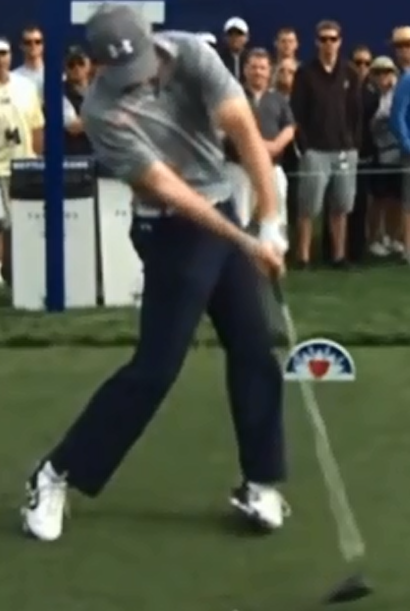 At about this point is when he starts to finally internally rotate the right shoulder because he has no anatomical choice to do otherwise. The easy way to depict this is to check where the left elbow is pointing. If the left shoulder is internally rotated, the left elbow will be facing the target. If not, the left elbow will face the stomach. I have been focusing (key word is FOCUS. I will get to this tomorrow on why I think it's important)...on that move the past 3 days. What I've found is that it's not easy to do and it requires you to get the pelvis rotation you need in order to pull it off. If you get lazy and sloppy with the pelvis rotation, you get bad shots. But when you do it 'right', it will produce great shots on a consistent basis. Last night I started to really get it and was hitting towering, climbing tee shots that had to be traveling 310+ yards legitimately (where I'm only about 30 feet above sea level). Some more stuff coming tomorrow... 3JACK |
|
|
|
Post by Richie3Jack on Jun 26, 2015 7:53:13 GMT -5
In this post I wanted to go into practice methodology. I can’t say I’ve created any of this on my own. I did this from talking to and reading stuff from people like Lucas Wald, Jeff Martin, Robin Cocq, Trillium Sellers Rose, Dr. Keith McDaniel, Adam Young, Dr. Richard Keefe (has a great book titled ‘On the Sweet Spot’) and a few others.
For the first 4 months working under Kelvin, my progress was slow. The main issue I had was the Right Pelvic Tilt and lack of Lateral Side Bend. They seemed almost mutually exclusive to me. If I worked on lateral side bend, I would go into RPT. If I worked on not going into RPT, I would not get any lateral side bend.
I would practice and practice and practice and still couldn’t get it. This seemed like a common problem for me. And I would recall back when I was younger I could catch on to new teaching quite quickly. Now with age and less time to practice, I was not nearly as quick of a learner.
Eventually, I wanted to know more about practice habits and started reading more on slow motion practice. This was right before Lucas Wald had a golf school in Orlando and I wanted to drop by and say hello, but I also wanted to get some confirmation on slow motion practice as we have seen the dramatic changes that Lucas made with his swing.
Here’s another swing change being made by one of Lucas’ students:
There is more to Lucas’ practicing methodology than going in slow motion, but I leave that for him to teach people. He can always be e-mailed at LucasWald78@gmail.com
Here’s the big thing about all of this that I learned and never recognized. Let’s say you are trying to learn new swing mechanics. For the purposes of this conversation, we will say that the new mechanics are ‘correct’ and the old mechanics or mechanics that are not the new mechanics are ‘incorrect.’
You would be better off hitting 100 balls and doing each of them correctly than you would be hitting 1,000 balls and doing 500 of them correctly and 500 of them incorrectly.
If you want to learn new movement patterns, it’s not only about getting ‘correct’ reps in, it’s also about avoiding ‘incorrect’ reps. Therefore, it’s not only about the total amount of ‘correct’ reps, it’s also about the percentage of ‘correct’ reps.
Each time you do a rep incorrectly, it means that you’re just helping further ingrain that ‘incorrect’ rep. Obviously, I would take hitting 1,000 balls and doing ½ correct and ½ incorrect over not hitting any balls. You do have to practice. But, the idea of hitting ball after ball and getting so many reps that it will eventually kick in is foolhardy. It will only start to really kick in if you’re doing a high percentage of reps correctly.
The other thing I didn’t recognize is:
The speed of the golf swing, not the length of the swing is what really makes it difficult for the brain to learn the new mechanics.
I have been based in the TGM methodology of going from basic to acquired to total motion. In M.O.R.A.D. and S&T they like to teach the golfer to go from P3 to P9. The same with Geoff Jones’ (aka SliceFixer) ‘9 to 3 drill.’
The problem with those practice methodologies is that it does not account for the speed of the swing and it takes away the most difficult part to learn….transition. Transition is where there is a tremendous change of direction with the speed of the swing and it makes it only more difficult for the brain to figure it out. So doing all of those half swing drills does not help as much as taking a full swing, but going in slow motion.
If I had the time, I would recommend not playing golf and just working on slow motion drills and not going full speed until you feel you are ready. It appears that is what Lucas’ student Andy is doing and I think he will pick up the full swing more quickly than I will and it will have a more permanent effect. Unfortunately, I value my time too much and living in Florida I can play almost every day of the year. So, I came up with my own bastardized version. I’m not saying this will work for anybody else, but it is just what I’ve been doing and it has worked for me.
Step 1 – loosen up the joints and get the blood flowing. I don’t take any full speed swings. This is about stretching.
Step 2 – WITHOUT a ball, take some swings at 10% speed which is incredibly slow like Hogan.
I may stop and try to get to certain positions. Exaggerate only when you are struggling with acquiring a certain movement. With the rest of the movements, I would make sure to not exaggerate. Remember, it’s all about GETTING THE MOVEMENTS ‘CORRECTLY.’
Step 3 – WITHOUT A BALL, I move to 25% speed with the same agenda. If I can’t get the movements correct, I’ll go back to 10% speed. Once I get things correctly, without a ball, I move to 50% and then 75%.
Step 4 – WITH A BALL, I go back to 10% speed but I don’t hit the ball, yet. I am looking at the ball. This throws an obstacle in my way and I’m trying to see how I respond to it. If I respond to it well, I will go to 10% speed and actually hit the ball. The ball may get topped, but the main focus is on DOING IT RIGHT.
Step 5 – Once I get comfortable at 10% speed hitting a ball, I go to 25% hitting a ball. Then 50% and then 75%. Again, it’s all about DOING IT CORRECTLY, not how well the ball is struck or how it flies. If I feel like I’m not doing it correctly, I will go down a notch in the speed. I’m trying to avoid doing it incorrectly as much as I can.
STEP 6 – I now go to 100% hitting a ball. However, I will alternate between 100% hitting a ball and then taking a practice swing (while a ball is in the way, but not struck) going at about 50% speed. If I struggle with a few full speed shots, I will step aside and go and do slow motion swings until I start doing them correctly. So, if I’m hitting 150 full speed shots, that means I have 150 corresponding practice swings at 50% speed.
STEP 7 – Any time I change a club, I do some warmups going in slow motion first. The new club is a new obstacle and we want to avoid doing swings ‘incorrectly’, so we need to slow it down first as we are most likely to do the swing ‘incorrectly’ early on. When I move to full speed, I continue to alternate between a full speed shot and a half speed practice swing. The focus in the practice swings is about the mechanics.
I’ve learned a lot of things about practicing this way.
A) For starters, you can work on more things at one time than you can if you are doing half swings at full speed. That’s why I emphasized the word FOCUS in the previous post. I can pick out 3 things to focus on for the next 2-3 weeks and start to ingrain them. Then I pick up a new 2-3 things to work on and my focus is on those things, but I can still work on the previous pieces as well. So in total, I may be working on 6 different pieces at once, but my FOCUS is on the last 3 pieces I decided to work on.
B) It’s important to have something to read about or watch when it comes to the mechanics. For me, I had read and talked to Kelvin about some of the mechanics and they made perfect sense, but in the end I didn’t really understand them. It was not until I started using slow motion practice that I started to really figure out how to get from Point A to Point B. And then I needed his articles as a reference to confirm what I had discovered on the range was what he was looking for.
C) You have to make sure to go slower in transition. That is where I have the tendency to speed it up and it actually needs to go slower.
D) I was practicing this diligently enough that I started to do some mechanics almost automatically that I had yet to practice. The big one for me was lifting the left heel up off the ground. I didn’t think I could possibly do it since I had been keeping the left heel off the ground for so long. One day I woke up and started to do some slow motion practice and noticed that my left heel wanted to naturally come up off the ground.
E) You can do this at home without hitting a ball and still ‘get it.’ Probably not as good as doing it correctly and hitting an actual ball, but you don’t need to hit 1 million balls to get it down.
F) If you do it diligently, you should not have to have ANY swing thoughts when you are hitting a shot at full speed
Part F is important.
Up until now, I always thought you were going to have some swing thoughts in a golf swing. Now, I realize that is actually not the case. Furthermore, I look back and see how nonsensical that concept really is.
I will give 3 examples. First, accomplished musicians do not have ‘music thoughts’ when they are playing music. My sister was an accomplished violinist to the point where she was accepted to the Julliard School. As kids, we would sometimes play the radio and see if she could replicate songs on the radio with her violin and she almost always got it right. She didn’t need sheet music and nor was she thinking about what strings to play in what order. Instead, she simply had a feel for what movements she had to make to produce what sounds that would come out.
Another good example is playing video games. If you play a game like Madden Football enough, you’re not going to think about what exact buttons to hit. Instead, you have gotten in enough repetitions that you can almost instinctually know what button to hit at any time.
Lastly, typing really hits home with me. I can type roughly 100 words per minute. When I had a slower typing speed, I would have to think out each letter of the word I was spelling. For instance, I would think out A-U-G-U-S-T-A in trying to spell the word ‘Augusta.’ But as I became faster and faster at typing I would just see the word ‘Augusta’ and had a feel and instinct for what key strokes needed to be made in order to type ‘Augusta.’
It’s funny because in golf we have resigned ourselves to having swing thoughts. Even though I have played this game since I was 11 years old, I never recognized how absurd it was to think that I didn’t put enough practice in for swings to become second nature and have a ‘feel for how I need to do it.’ This is the sense you get from Bubba when he discussed how he hit that famous wedge shot at Augusta:
Now, some of the mechanics were a bit unnecessary (i.e. Bubba hooding the face), but it was more or less about Bubba knowing the shot he needed to hit and having a sense of what movements he needed to make in order to get that ball to fly how he wanted.
This is where I think the golf instruction industry really screws things up. They talk about ‘feels’ and ‘visuals’, but in reality they are talking about swing thoughts. ‘Pulling the shaft off the head’ or ‘Dragging the Wet Mop’ is NOT A FEEL.
I’ll say it again. ‘Pulling the shaft off the head’ or ‘Dragging the Wet Mop’ IS NOT A FEEL.
Those are swing thoughts. And when we are actually in the process of hitting a golf ball at full speed, we don’t want swing thoughts. We should get to the ball and have developed a second nature ‘feel’ of how we need to move in order to get the mechanics we want (regardless if we are learning Kelvin’s work or S&T or M.O.R.A.D. or TGM or 1 plane swing, etc).
The only time I have swing thoughts is when I’m on the range focusing on something new.
That’s it.
On the golf course, I take a slow motion swing in my practice swing. I then simply try to feel those mechanics when I get up to hit the ball.
3JACK
|
|
|
|
Post by pavaveda on Jun 26, 2015 15:10:08 GMT -5
Excellent series of posts Rich. Good to have you back posting some of these on your forum.
The very last topic about not having any swing thoughts, reminded me of something I discovered that helped when playing golf, and that was to stop trying to make a such and such a swing, but instead focus on where the target is and hit the ball to the target. That's really what the game is about. I'm not a very good golfer (17.7) and unfortunately didn't play as a kid, but I know that my results are better when I'm focusing on hitting the ball to the target rather than trying to make the perfect swing. I suppose that is what they mean when they say, "Play golf. Not golf swing." But they leave out the idea that you don't really need any *swing* thoughts either.
|
|
|
|
Post by Richie3Jack on Jun 27, 2015 19:49:49 GMT -5
Thanks Russ.
A big part of the issue with traditional teachings by anybody (not just from instructors) and saying things like 'be confident' or 'don't have swing thoughts' or 'play by feel' is that it doesn't tell you the 'how' and the 'why' behind it. It's hard to stay confident after you pumped 3 tee shots in a row in the woods and your swing feels like shit and you have no idea what is going on. It's tough to not have swing thoughts or play by feel when you have misconstrued what 'feel' really is and your practice regimen is designed to have swing thoughts and not incorporate a feel for what you're doing.
So it's easier said than done. After a while people started to struggle with this type of traditional instruction and started to think that it couldn't be done.
And it's also not just about the target. It's about being able to keep your composure. Very easy to sabotage yourself when you are hitting it poorly, but also easy to sabotage yourself when you get off to a hot start.
3JACK
|
|
|
|
Post by Richie3Jack on Jun 28, 2015 17:48:23 GMT -5
I remember the first time I sent Kelvin a video and he discussed some of the things I needed to work on. One of them was getting more right shoulder external rotation on the downswing and sustaining it. As you can see, I would go into internal rotation a little after p6. That causes the right shoulder to stall out, you lose any chance of doing anything remotely close to lateral bend and it rolls over the clubface. I tried that at the Legends course at Orange Lake and shot 69 (I've shot 68 there before). I had not been playing well lately and just focusing on the right shoulder ER had me hitting the ball far better. Later that day I skyped Kelvin so we could talk about the video and we discussed more of the things he wanted me to work on. A lot of people ask me about Kelvin's work and what entails it and I usually tell them " it is almost the exact opposite of how everybody else teaches." To understand what that means, we need to understand what goes on with the club path when you move laterally (linear) or when you open up (rotational). Linear movement of the body = tendency to swing the club inside-to-out Rotational movement of they body = tendency to swing the club outside-to-in One of the ways I look at the natural progression of the swing is that beginners usually go rotation with everything. They open their shoulders, torso, hips, etc. So the path will naturally move well outside-to-in and that helps cause slices. Eventually, if the golfer keeps playing and works to improve...they'll start to figure out more linear movement and the knees and hips will slide along with the torso and the shoulders will go more 'underneath.' The golfer will now be a better player, but when the struggle it will usually be with the hook. If the golfer then starts to continue to work to develop their game, they may likely come across a golf instructor that will teach the golfer to be more linear with the hips (inside to out path) and 'swing left' by rotating the torso and 'chasing the right shoulder down the line' (outside to in). The combination of the linear lower body and the rotation upper body will offset each other to square up the path. Kelvin teaches is the opposite way. With the lower body moving rotationally and the upper body moving more linear. What I see out of a lot of the biomechanical people is that they still use the upper body rotational and lower body linear principle. The idea is for the Center of Pressure to trace back and forth almost in straight line (usually a small arc). Get somewhere roughly 75% of the CoP on the left foot at impact and push off the ball of the left foot. Chris Welch talks about it in this video: My interpretation of this is by pushing off the ball of the left foot is to use the 'push force' of pushing off the ground as the primary ground force. And if you put most of your pressure on 1 leg and have that knee flexed, then you straighten that leg, the pelvis will rotate along with that. And that pelvic rotation is more of a 'secondary ground force.' With Kelvin's teachings, it's more that the pelvic rotation is primary and the pushing off the ground is more secondary. One of the major pieces that caught my eye is looking at the all time great ballstrikers, both from history and from the modern day and looking at their impact positions. 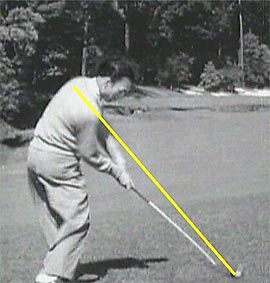 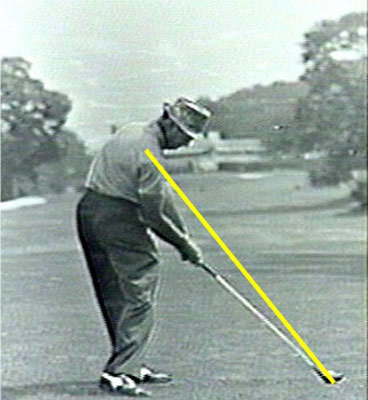 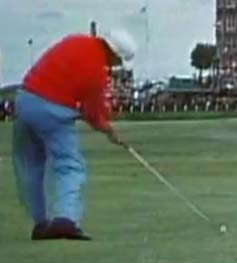  You just see plenty of pelvic rotation and the spine has bent laterally without any right pelvic tilt. Furthermore, the right forearm is closer to being 'on plane' (aka in line with the golf shaft) at impact. When I look at a lot of modern teaching I tend to see less pelvic rotation and the trail forearm being well above the 'plane.' Much like Mickelson does:  Certainly, one can play some great golf from there. Mickelson is traditionally a fantastic iron player and generates about 118 mph club speed. I know Kevin Streelman has a very clean CoP trace and is a fine driver and Red Zone player. But, Mickelson has been for good stretches, a putrid driver of the ball. And Streelman isn't nearly as great from 75-175 yards and I question if he's at the level of the guys with superior pelvic rotation with their right forearms on plane like Spieth, DJ, Bubba, McIlroy, etc. In fact, the new wiz kid on Tour this year is Brooks Koepka. 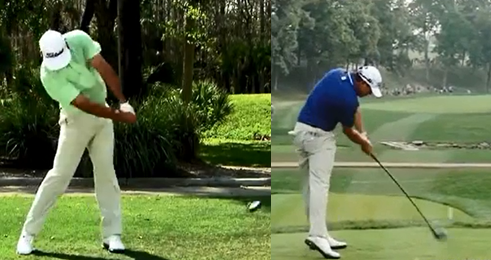 I'm not saying that there's a 'right way' or a 'best way', but Kelvin's work made a lot more sense to me. Furthermore, with Kelvin's philosophy of the lower body going rotational with the upper body more linear, the coupling motion would allow for the hips to continue to rotate even more. This was pointed out in this video with Andy Plummer and Dr. Bob Olivieri So it was easy to see how Kelvin's principles could create a lot of power. The rotational force was going to be enhanced with proper lateral spine bend. And my experience always was that when the pelvis starts to stall, the face tends to roll over. So if you had the great amount of pelvic rotation, one could hit the ball not only further, but likely straighter because the clubface was going to be more 'stable.' 3JACK |
|
|
|
Post by Richie3Jack on Jun 29, 2015 14:10:59 GMT -5
Perhaps my biggest issue when I initially started working with Kelvin was that I had to compartmentalize what I wanted to work on and in what sequence I should work on them. I probably had 15 or so glaring issues that needed to be repaired, but working on them all at once is impossible. Furthermore, I had poor practice habits when it comes to developing new movement patterns for a male adult in his 30’s. Hitting ball after ball may work for a teenager or even somebody in their 20’s, but at this stage it is going to have limited returns that will take a long time to develop. The good thing is that when I started to change my practice methodology, I found that not only could I develop new movement patterns more quickly, but I could work on more things at one time. It really shattered my belief that you could only work on 2 things at once. In reality, you can probably work on 7 things at once if you really take the time and have the patience for it. I tried the ‘big fish to fry’ methodology of working on the things that I have the longest way to go on and focus on them. The #1 thing to attack was the lack of lateral bend of the spine. I also worked on right shoulder external rotation in the downswing and trying to rotate the pelvis. In the end, if I worked on lateral bend, I would get into right pelvic tilt. And if I worked on getting rid of right pelvic tilt, I would not get any lateral bend. After a few weeks, I decided to focus on the backswing first. Then when I saw Kelvin at his March clinic in Port St. Lucie, I moved on to focusing on the lower body and still work on the backswing. One key video that helped me more with the backswing was this one from Lucas Wald: From there, I found it helpful to understand that the pelvic and the hips are 2 different things:  In layman’s terms, the hips are on the sides of your waist and the pelvis is that bone that goes around your waist. The thing is that the pelvis and hips can move independently of each other. I can rotate the hips one way and get the pelvis to rotate another way. In Kelvin’s protocol, we want as much pelvis rotation as we can get. I think in M.O.R.A.D. there is some limit in terms of backswing pelvis rotation that they want, but in general they are looking for ample pelvis rotation. The trick is to use your hips to get that pelvis rotation. And as Lucas points out in the Zaharias video, we want dual internal rotation of the hips in order to rotate the pelvis. I think Nicklaus does it spot-on here.  The picture circles his left heel coming off the ground. I could not get the left heel off the ground because I had never done it before. But, after working just on the hip rotation, one day out of the blue I literally woke up out of bed, started to work on my movement pattern training and was automatically lifting the left help off the ground. The left heel off the ground can assist with getting more left hip IR and can assist in keeping the hips more level. If you get that LPT in the backswing, chances are you’re going to go into Right Pelvic Tilt in the downswing and after experiencing RPT and seeing some greats like David Duval start to develop RPT, I’m convinced that RPT is a killer of good ballstriking. The other part that Jack does so well is getting his hands high. So, my backswing thoughts in practice is to simply get dual IR of the hips and get that right hip joint moving backwards as far as I can. Then I simply try to get my hands high (or ‘reach for the sky’ like Nicklaus was taught). I would prefer to get as high as DL III here.  But for now, I’m mostly focused on the lower body. And yesterday I hit one 263 yards carry into a 12 mph head wind. 3JACK |
|
|
|
Post by Richie3Jack on Jun 30, 2015 8:47:45 GMT -5
I started working with Kelvin in mid-September of 2014. By January 2014, I had focused most of my efforts on the backswing. From there, I focused most of my attention on getting the lateral side bend until the March clinic at Port St. Lucie. At the time I wasn’t fully understanding proper movement pattern training, so I still had some swing thoughts. And my typical swing thought was to get lateral bend to start the downswing and make sure to open up the body so I won’t hit hooks. I was hitting the ball respectable enough, although I did hit some large draws. I do remember one time, playing a course called SummerGlen with my dad where I felt I got the lateral bend correctly. It felt much different than any swing I’ve produced and it was very forceful. Typically, my dad plays from the white tees (nearest the ladies tees) and I play the tips. When we both hit one well, I usually outdrive him by about 10-20 yards (at this point in time). But that drive went about 70 yards past his. In fact, too far for its own good. Later on when I went to the March clinic with Kelvin, I liked the amount of side bend I was getting, but I was cheating it with right pelvic tilt. And that was causing too much slide. The reason for the over-draws is that I was getting so underneath with the side bend and didn’t have the rotational movement of the lower body to counter it. So it produced a path well out to the right. That’s when I got introduced to the concept of keeping the left hip behind the left ankle at impact. I had read Kelvin’s articles on the Chi Line, but I didn’t quite understand the importance of the left hip’s position relative to the ankle. Here’s a couple of pics of Ernie Els that I saw that really enlightened this for me.  The picture on the left was taken in 2007 when he was generating about 117 mph club speed. The one on the right was taken at the Irish Open this year as he’s generating only about 110-111 mph club speed. It’s a slight difference, but the results say a lot. And we see it in this video from Kelvin of players not exactly ‘posting up on their left side.’ What’s funny is that there is an 8-year old kid at the range I am a member at who has that similar leg and foot movement as Scott Stallings and for his age, he murders the ball. And he’s not even that big for his age. He’s just finding a way to rotate the pelvis. The other thing Kelvin discussed was in this video With that, I initially focused on trying to feel like I was simply moving my left butt cheek back and away from the target at impact. The problem was that I was using a ‘visual’/’feel’ which is actually swing thought. And I didn’t properly diagnose the movement needed and practice to ‘get it right’ so I could then develop a ‘kinesthetic feel’ and repeat the movement without having to think about it. The other issue is that I had the movement incorrect. It wasn’t until I started to practice more in slow motion that I started to fully conceive the movement. 3JACK |
|
dhc1
'88 Apex Redlines
  
Posts: 178
|
Post by dhc1 on Jun 30, 2015 9:04:22 GMT -5
Do you drive/hold with your mid/short irons? I believe kelvin suggests a different swing for shot requiring distance control.
Thanks.
|
|
|
|
Post by Richie3Jack on Jun 30, 2015 10:46:11 GMT -5
I don't drive hold with my S-Wedge or L-Wedge. I will with the P-Wedge and 9-iron. Although it depends on what the shot calls for. If I'm in between clubs or into the wind, I will hit more punch shots to keep things more under control. But, if I have the club and there's no wind, drive-hold away.
3JACK
|
|
|
|
Post by Richie3Jack on Jul 1, 2015 9:02:27 GMT -5
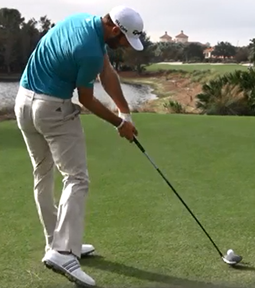 There’s a great video (that I can’t find) from My Swing Evolution’s YouTube channel where they show a MMA trainer discussing MMA fighting and how to move certain ways requires you to do the opposite of what you think. It kind of reminds me of the movie Let it Ride where Richard Dreyfuss comes up with the idea to poll race track betters who they pick to win and he bets the exact opposite horse. Golf tends to work in that way where common logic is sometimes the wrong way to do things and you need to go in the exact opposite fashion. The picture above has that lower body action we are looking for. You can see both butt cheeks and almost the entire back of the left leg. If he was doing the ‘bucket drill’ he would easily knock over the bucket. The yellow arrow shows the movement of the pelvis. So, logically we would want to rotate everything in the same direction as we want the pelvis to rotate. This is where I had one of my major breakthroughs and it came from using slow motion practice and concentrating on getting the movement ‘correct.’ A big part of slow motion practice is that it allows you to ingrain the mechanics you want more quickly. But the other big part is that if you know what you want the mechanics to LOOK like, but struggle to get them in the full speed swing, you can start to connect the dots and figure out what you do not accurately understand. In this case, I want the pelvis to be well open at impact, I want to be able to see the back of the left leg if I were filming from the DTL view and I have to keep the left hip behind the left ankle. After some time just focusing on those mechanics in slow motion, I started to see the folly of my ways. I have to do the exact opposite of what I would logically think I would have to do. Remember, the pelvis and the hips are not the same things.  So, if I want to rotate that pelvis counter-clockwise, the left hip in particular needs to rotate clockwise. After discussing this, I rushed home to see if I could find it in Kelvin’s articles and there it was…if a player continues to externally rotate the left hip he will get into early extension and slide. And this video from Lucas further showed evidence of how the greats got that pelvic rotation: But another key part to all of this is what Lucas discusses…left leg extension. I think a lot of people are in fear of left leg extension because of the rumor of Tiger injuring his knee from ‘snapping the left knee’ thru impact. However, Hank Haney writes in The Big Miss that Tiger suffered that injury thru doing one of those Navy SEAL experience training courses. There are plenty of players that really extended that left leg over the years. 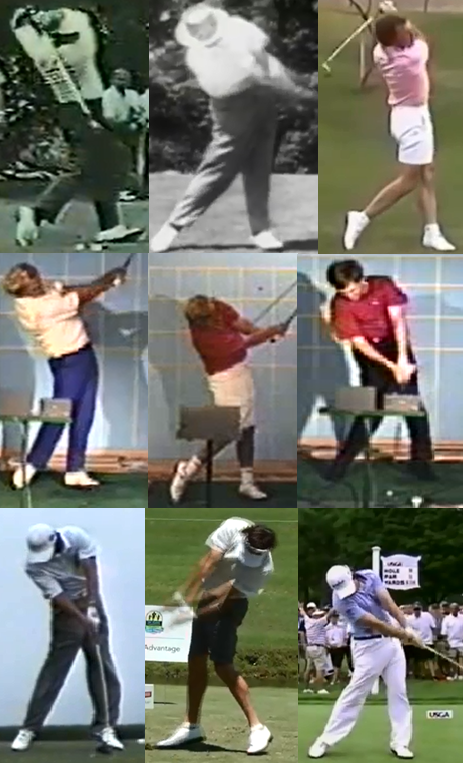 In fact, I just don’t know of golfers that suffered knee injuries. Usually it’s back injuries, shoulder injuries, wrist injuries, hip injuries and rib cage injuries. But knees? Just don’t know of many and they do a ton of walking. Furthermore, Nicklaus played football and basketball in high school. Mac is an avid runner. Daly was a good high school football kicker and Bubba played basketball as well. No knee injuries. So, I tend to believe the entire “snapping his leg caused Tiger’s knee injury” is misplaced. Anyway, the straightening of the left leg is so critical to the downswing and it becomes very difficult to get enough leg extension before impact. One swing I've seen develop over the years was Christo Garcia's (My Swing Evolution). I would look at how his left leg extension is present whereas when he was struggling years ago. On the left was his swing in 2009 and on the right is his swing today. Getting that left leg extension and doing it at the right time is so undervalued, IMO. 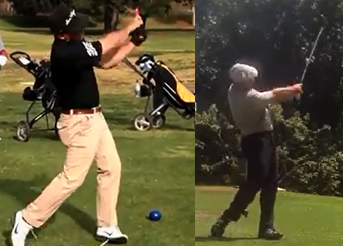 However, the bigger discovery was about how the hips have to move in order to get that pelvic rotation I wanted. Once I started to understand that, I could then get a lot more of the lower body pieces to fall in line. |
|
|
|
Post by Richie3Jack on Jul 2, 2015 8:56:24 GMT -5
If there is one critical point I have learned in my time working with Kelvin is that if you’re going to make swing changes the true test of whether it is worth your time is if your good/great swings produce better results than you did with your old swing when you made a good/great pass at it. You’re going to hit bad shots in the midst of a swing change. In fact, you should hit more bad shots because the mechanics are so foreign. But, if you’re not producing better top-tier shots then you probably should have stuck with the swing you had and work on changing a few nuances. When I discovered the hips have to eventually internally rotate again so the pelvis can rotate counterclockwise and you don’t get into Early Extension, I started to hit some fantastic shots with a lot more power to them. The problem was that I was still hitting some horrific shots. I think in the past, I may have given up on the swing change, but knowing what I know now…I stuck with it and worked to figure out the kinks. What I like so much about Kelvin’s teaching is that the mechanics of the swing are fairly simple to understand. A lot of people say ‘well, he has all of these micro moves and I’m supposed to remember them?’ But, what they don’t understand is that it is more of a catalog of what he has discovered. You don’t have to memorize even half of them, but if you’re looking to figure out what your issues are and/or need reference material, that’s what his articles are there for. I know longer have swing thoughts when I’m out on the course hitting a shot. And a lot of times, my only swing thoughts on the range are when I’m going in slow motion. But, when I do sit and ‘think’ about Kelvin’s swing it is: - Dual hips IR on the backswing - Anterior Pelvic Tilt in transition to automatically get into dual hip ER - Back into getting dual hips IR into the finish. There is some right shoulder ER in the downswing thoughts that I’m working on right now. But, for the most part I think of my hips like a radio dial and I just go IR into ER back into IR. At about his point in time I started to read Patrick Cherveny’s work on ‘moving the middle’ instead of ‘starting the downswing from the ground up.’ I had never been actually trained to ‘start the swing from the ground up’, but I had teacher after teacher see me start the downswing by ‘kicking out the left knee/shin’ towards the target and say that was ‘good.’ 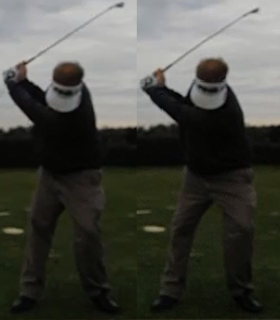 The swings I posted in the original post show it. It’s a very slight movement, but it’s certainly there as you can see the distance between the left and right knee widen while the pelvis is basically in the same position. At this point I was coming off the March clinic with Kelvin and he told me that I need to focus more on the pelvic movements than on my leg movements. I needed to get into Anterior Pelvic Tilt and Left Pelvic Tilt more than worrying about left leg extension and ‘kicking over the bucket’ in the bucket drill. I was also reading sports biomechanist Patrick Cherveny’s thoughts on ‘moving the middle’ and how many biomechanists think that the swing should start from the ‘ground up.’ Cherveny’s thoughts made much more sense. Especially when you watch power hitters in baseball and golf swing. Kelvin posted a great video on this: Again, this is another example of reading and watching something and it making sense, but not quite fully understanding it. And it wasn’t until I started to do some slow motion practice that the lightbulb went on. As I was working on getting internal rotation of the hips to rotate the pelvis, I started to notice that my left knee/shin ‘kick out’ (aka starting from the ground up) was throwing me fits. I started to conceive it as ‘getting into Anterior Pelvic Tilt too late.’ Meaning that I was already sliding before I got into APT. I then thought “ what if I hold my dual IR at the top of the swing and not move it until I get into APT?” My initial worry was that my pelvis and torso would probably be too closed to the baseline by the time I hit P5 and I wouldn’t get any rotation. But, I tried it anyway and I found out that not only does it work, but it actually forces my hips to go from dual IR into dual ER (the Sam Snead squat look). It does it automatically without having to consciously try to execute the Sam Snead squat. And I could also start to feel something that Victor Rodriguez discussed in this video of ‘spreading the pelvis.’ So instead of going into dual IR and then CONSCIOUSLY thinking of getting into dual ER, I could just go into dual IR…then sustain that IR and just go into Anterior Pelvic Tilt and that will get the dual ER I want. Then I just go back into dual IR. It’s almost like imagining your hips are two radio dials and you are turning then both inward, then outward, then inward again. But the outward is done simply by getting into Anterior Pelvic Tilt. I raced home once again to see what Kelvin’s articles said and to look at videos of golfers swings. And sure enough, Kelvin discusses how the transition is started thru APT. And you can see it in this swing by Lucas Wald.  I drew some lines to show how he has more ‘angle’ to his left leg while my left knee would have ‘kicked out.’ I also found that using APT to get the dual hip ER will not get the body too closed to the baseline. In fact, when I do it now with my left heel lifted in the backswing, my pelvis is actually open to the target by the time my left heel lands back on the ground. This is when I started to realize what ‘moving the middle’ really was and the issues of the ‘starting from the ground up’ mechanics. |
|
|
|
Post by Richie3Jack on Jul 6, 2015 13:40:13 GMT -5
I have not really gone into lateral bend yet because I think that for a person of my age, that requires more fascia training in order to get that lateral bend. In fact, at the March clinic with Kelvin, one of his students who is older than me and swings with some real speed said that he legitimately gained 30 yards off the tee and almost 2 clubs with his irons just by doing the fascia training alone. That’s when he started to delve more into what Kelvin was teaching because if simple fascia training worked, then what wonders could the mechanics do?
I joined the site that Kelvin and Gabe Writer put together at mti.gabrielwriter.com and it is well worth the money because there is so much different information. It’s much like Kelvin’s articles, but in a video format so it is easier to comprehend. It includes fascia training, short game and putting along with the golf swing.
Another big part to lateral bend, IMO, is getting the right forearm on plane. It was easy for me to notice that the players that had the right forearm on plane also had lateral bend and vice versa
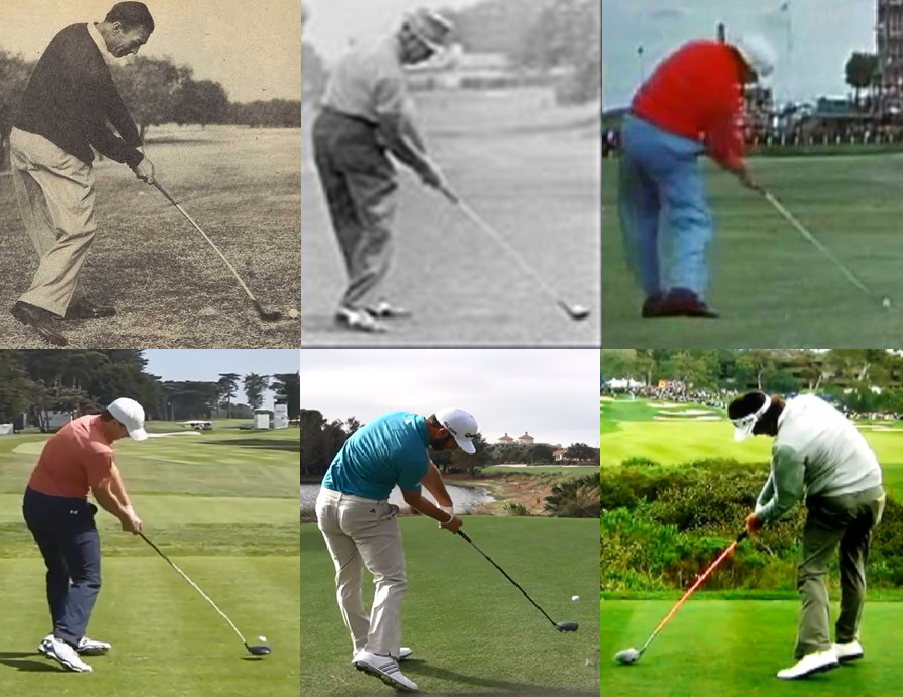
I think this is something that we don’t see from modern instruction and now more of the forearms are above the plane (in line with the shaft) and we are seeing less lateral bend. As Jeff Martin told me at Lucas Wald’s Orlando clinic in January, it has a lot to do with a good right elbow move and sustaining the right shoulder external rotation. Still, there is fascia training involved (which includes exercises for the right elbow move and right shoulder external rotation) and hopefully when I start to get going on that I can better perform those moves.
*** Before I started to work on a right elbow move and after I had discovered the importance of getting back into dual hip IR into impact and how to ‘move the middle’ in transition I started to work more on the backswing. The big thing I worked on was getting that right hip working more back and behind me. Lucas Wald discusses this in this video: I actually think this move is pretty simple, just keep internally rotating the right hip. In fact, I recently had a few struggles on the range and discovered that I wasn’t quite internally rotating the right hip. Instead, I was more swaying due to focusing too much on getting right loaded in the backswing. But, if you internally rotate the right hip enough, you will probably get all of the rightward load you need. And I don’t think the rightward load is as big of a move off the ball as some think. Here’s Lucas Wald hitting a shot with a 6-iron and I started to pay close attention to his head.  All of Lucas’ lateral movement of his head occurs before he hits p2. And it is only a slight lateral movement. From there, the head rotates due to the pivot and raises. The right load is about getting the pressure to the right leg and really keeping the hips more level instead of getting into left pelvic tilt and perhaps lowering the head because of that left pelvic tilt. When I started to look at his deep right hip rotation that showed to me what the right load is about instead of making a big move off the ball. All the while I was working on this, I had read the discussion of the lost art of lifting the left heel off the ground in the backswing. 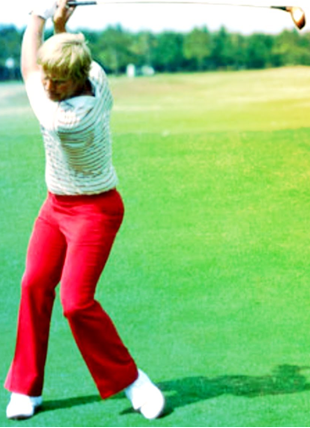 I had never lifted the left heel off the ground, so when I first tried it, it wasn’t working well and I just let it be. But, I felt that there were obvious benefits to lifting the left heel off the ground. It allows for more hip rotation and that will rotate the pelvis more in the backswing. And it prevents the golfer from getting Left Pelvic Tilt in the backswing and lowering the head. What I also found is that there are a couple of ways of getting that left heel off the ground. One is the Nicklaus way where his heel is noticeably off the ground and he is more on his big toe of his left foot. The other is the Hogan way which has more of the inside of the left foot on the ground and the outside of the left foot comes off the ground. 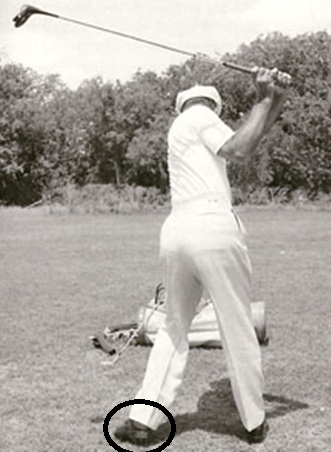 After doing the slow motion practice and working on getting dual hip IR and getting that right hip moving more back and behind me, one day I woke up and started to practice and noticed my left heel was unconsciously coming off the ground. I would say my left heel at the top of the swing looks more like Nicklaus or Bubba than say Hogan’s. But, this left me with a new learning curve. Even though I was able to automatically get the left heel up off the ground in the backswing, I now had to learn how to get Anterior Pelvic Tilt in transition, not slide the pelvis and get proper dual ER and into dual IR of the hips on the thru-swing. At first, I worked hard on getting the tailbone to move back immediately in transition. But, in the end, I found that it was still best to work on APT in transition. I just had figure out what I was doing and then figure out how to correct it. After a while of slow motion practice, I found the problem was that I was sliding more in transition and then going into APT. So I really worked on the visual of getting into APT in transition by feel that once I hit the top of the swing, my tailbone moves straight backwards as I’m getting APT. I visualize it like this. 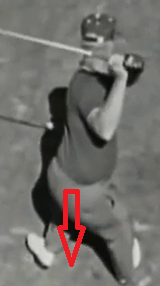 I’ve found that when I get that right hip back and behind me thru internal rotation in the backswing and then go into APT and ‘move the tailbone straight back’ combined with the marching move, the pelvis gets open by the time I hit P5. By then, I had completely revamped my lower body action from the way it moved in the backswing (hips dual IR with left heel off the ground) to the transition (not kicking out the left knee and using APT to 'move the middle') and throughout the downswing into the finish (getting into dual hip ER and then going into dual hip IR). I still get a little 'slidey' from time to time. But I can usually tell that by either misses to the right, low spinny shots or bad mis-hits (usually off the toe). When I go into RPT, usually the ball starts to miss left. But for the most part, I no longer miss left and that has had a profound impact on my scores. |
|
|
|
Post by Richie3Jack on Jul 7, 2015 8:23:40 GMT -5
In M.O.R.A.D. Mac coined the phrase that it was ”80% Snead and 20% Hogan.” I never quite agreed with that notion simply because there is far more to M.O.R.A.D. that just Snead and Hogan’s swing. There is a ton of biomechanics, neuroscience, geometry, physics, etc. involved. And any credible M.O.R.A.D. based instructor will show you various golfer swings like Palmer, Nicklaus, Greg Norman, Casper, Kite and a host of others. I often get asked the question ”what does Kelvin teach” and for the same reason why I don’t like the M.O.R.A.D tagline is the same why I’m averse to put Kelvin’s work in a nutshell. But, the best I could do is that Kelvin believes in a ‘stable club head’ thru impact (aka drive-hold release) and getting a good amount of pelvic rotation while minimizing slide in the downswing. What tends to draw the most attraction to Kelvin’s work is how far his students hit the ball. But, the biggest thing that I’ve seen Kelvin concentrate on is the drive-hold release. That stabilizes the clubhead or you can call it ‘slows the rate of closure’ and ‘slows the overtaking rate’ and you can produce more consistent face angles, dynamic lofts and paths at impact. For instance, Jim Furyk doesn’t hit it long, but drive holds it nicely.  The thing with the distance is that Kelvin also teaches mechanics that improve distance as well. And much of the time for most people, the mechanics involved with distance are often used to execute the drive hold release. But, the reverse is not true. Some players can hit the ball very long without a drive hold release, like long drive champ, Joe Miller. 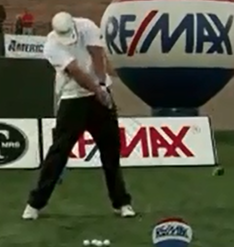 Miller is a huge guy and much larger than Jamie Sadlowski. Having watched both hit in action, Miller is very wild and Sadlowski is very accurate and precise. In fact, GEARS did research on Sadlowski and said that they had never measured anybody at his speeds that had anywhere near as tight of an impact dispersion with the driver. Sadlowski usually hits a small draw with everything and I could see him destroying more open courses in the area like Orange County National, Metrowest, Harmony Golf Preserve, etc. *** One of the first things I learned from Kelvin was the external rotation of the shoulder. Since I got back into the game, I always had a nagging issue with getting ‘above plane’ on the downswing. Dr. Sasho MacKenzie prescribes that the ideal physics would have the club head’s path on a flatter ‘plane angle’ than the plane of the hand path. We get this by pronating the left forearm in the downswing. 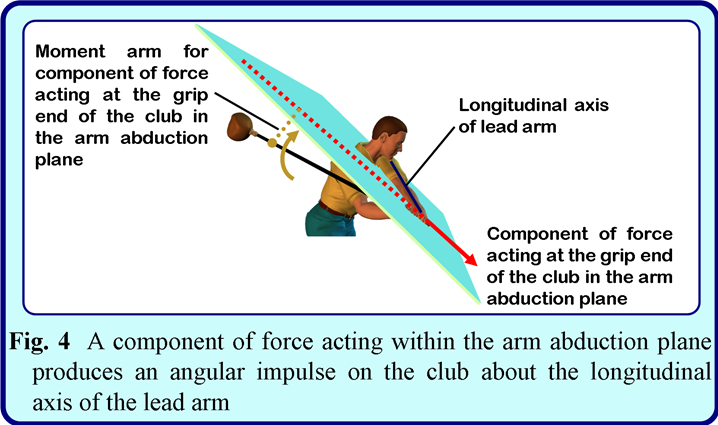 I did this before I started to work with Kelvin and it worked in shallowing out the plane and producing good shots. However, I found some issues with it. For starters, it doesn’t consider the trail arm because MacKenzie’s model doesn’t include the trail arm. If you separate your elbows further, you can pronate the left arm, but still have right shoulder internal rotation and you won’t produce the correct hand to club head paths. The other issue is that I don’t think it considers the release. It can become very easy to flip and roll with this and that was a major issue for me at the FSGA Mid-Am…I couldn’t stabilize the club head. *** Eventually, I started to externally rotate the right shoulder and get enough rotation where I wouldn’t roll the face over. I may flip it a little, but I wouldn’t roll it. That meant I could hit it straighter more often. And that’s when I started to recognize what a ‘1 way miss’ was all about. My believe is that for better golfers, regardless of swing style…you’re going to have open face misses. We simply cannot control that when playing even at the highest level possible. I really started to notice this as I went to Tour events and found the range and every one of the better ballstrikers on Tour usually had a flare-right miss. And the lesser ballstrikers usually had a draw curvature with more bend to it and would miss left and right. They simply cannot stop a miss to the left. The better ballstrikers can prevent that left miss. For me, I started to be able to play dogleg lefts and left to right wind far better. I could simply aim everything a good bit to the left and swing away because I may hit the left corner, but I wouldn’t miss left. Or if I had plenty of room on the left side and some trouble on the right side, I knew I could ‘let the shaft out’ and I wasn’t going to miss left and likely hit a long drive down the middle. The only thing to note is that you want to be able to avoid the left miss and still be able to draw the ball if needed. That’s what separates the players from the hackers. The hackers may not miss left because they slice it all day. But the hackers simply cannot hit a draw on command, ever. *** One of the more interesting things I’ve learned in this process is how the straight left arm at impact is a fallacy. The greatest example today is of Jordan Spieth.  I never really knew that wasn’t the case in golf. As Kelvin says, we want the left elbow facing more towards the target instead of towards the stomach. You can see Jordan’s left elbow pointing more towards the target and Nico Bollini’s (below) pointing towards the stomach. 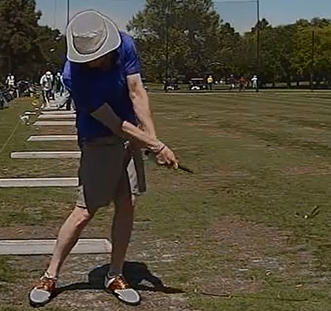 Completely different rates of closure and Spieth is doing it with a much more difficult club to not roll over in the driver. That was something I started to purposely work on; getting the left elbow facing more towards the target. That requires the left shoulder to be internally rotated and the right shoulder to be externally rotated. The first day I focused on it, I was hitting some beautiful shots. But, after a while I just kept struggling with it. That’s when I started to focus more on getting the right shoulder external rotation and sustaining it. If the right shoulder remains more externally rotated, the left shoulder will likely sustain its internal rotation. I found this video to be helpful in understanding the right elbow move. Essentially, the 2nd line drawn should be more upright if we are doing the right elbow move correctly. Brian Gay doesn’t have a right elbow move and the 2nd line drawn is now flatter.  Another way to look at it is from this view, where we can clearly see Dustin’s right elbow underneath his left arm. I like to practice a lot of slow motion for this and hold the impact position for a few seconds. This is where I can feel the upper body working more linear and 'under' while the lower body is more rotational and 'across.' The other feel is the sense of the club head not being able to close. In any other swing if we work the upper body more 'under', we will roll the face. But with the lower body rotated and sustaining the right shoulder ER, the face stays square with this swing. I saw a similar video to this one at the US Open. This provided me with a good visual to conceive how DJ makes it appear so simple. He just looks like he gets that right elbow moving forward and in front of his right hip and sustains that and then just lets the body rotation bring the club head all the way to the golf ball. Brilliant. |
|
|
|
Post by Richie3Jack on Jul 8, 2015 8:32:00 GMT -5
This past weekend I shot 66 (-6) at Juliette Falls which as a 75.4 index. I don’t think it’s THAT hard, but it’s still a good test. The par-3’s are the real tough holes and they have some difficult drives on the par-4’s. Then on Saturday I shot 65 at the Havana Club. It’s a 73.4 index, but I had an easy time with a lot of wedges into greens. The course record is 63 by Patrick Reed, so I wasn’t too far off.
I then played LPGA International, the Arthur Hills course. This course doesn’t suit me as well and I played it even par for 9 holes before the storm rolled in. So, for 45 holes, I was -13 with 14 birdies and hit 38/45 GIR. I did hit one drive on #6 that I had Google Earthed the hole the day before since I don’t know where to aim. Well, I hit it where I specifically thought where to NOT hit it. But, it carried the water. I didn’t get any roll as the ball nearly plugged. I found a spot to where I could identify where the ball landed so I could Google Earth it to see how far I carried the ball. When I got home I found that it carried 272 yards. Into a 8-10 mph head wind and we are only about 15 feet above sea level. So, I figure that drive was probably struck at close to 114 mph club speed.
I had been struggling a little with my swing up until that point. I was working on keeping left shoulder IR in the swing and just couldn’t produce the same shots I was hitting the first day I tried it. On Thursday night I snuck out on the range during another storm that was about to hit and concluded I should just focus on sustaining the right shoulder ER instead of working about left shoulder IR.
I had some people ask me “what’s the difference in you now shooting such low scores?”
If we are looking at it from a pure statistical standpoint, my iron play was really good. Juliette Falls has extremely difficult par-3’s. I hit one to less than 6 inches and the other, which you have to draw it around a tree over water, to about 1-foot. At Havana I started putting better, but I was still sticking shots close all day. If I had to guess, my proximity to cup on my birdie putts at Juliette Falls was close to 20-feet on average. And it was probably at 25-feet at Havana (anything under 25 feet is great).
But, my driving has become more effective simply by hitting it further.
Mentally, I’m much better. I’ve been following Jordan Spieth’s cue and verbalizing what I want to do before the shot and then verbalizing what I thought about the shot after the shot. This really works well because it helps continue to keep my external focus. Shawn Clement discusses it so well here.
Verbalizing my post shot helps as well if I make a bad pass at the ball. For example, if I don’t get into APT correctly and end up early extending I can feel myself do that and slide instead of rotate. And often times it will result in a cut. So, I then verbalize what I felt I did wrong. That helps me remember that for the next shot. But, I do not want to have swing thoughts when I’m hitting the ball. That is internal focus.
Instead, I use that verbalization to remember it and use that swing thought in the slow motion practice swing. I can then start to truly feel and sense what I have to do and when I step up to the ball, my focus is external (on the target and the shot I want to hit to that target) and I simply can feel myself getting into the mechanics I want to get in instead of actively thinking about APT or any other swing thought.
It’s why I think some great players come off as really cocky. They are actually externally focused and they use that to hit the shots they want to hit. So, they can say ”hey, you want to see me hit a high fade?” and then do it on command.
I think that is how Moe looked at it.
And I think Moe was spot-on. So much talk about mechanics, but so little discussion of the mental part of the game. When Moe talked, people always focused on his discussion of mechanics and swing thoughts/visuals. They usually ignored what the mental part of the game was. Moe was also known for doing slow motion practice and going on for hours practicing holding certain positions. He knew how to practice to get the mechanics and to repeat them. Then he used external focus to hit the shot he wanted instead of hitting the positions he wanted. The positions had already come with the countless hours of good practice. And he had the true confidence, knowing that he could always make up for a bad shot. As Moe says “a bad shot can only hurt my vanity and vanity is the luxury of fools.”
Lastly, the mechanics are such that I can’t miss left anymore. I think that is hugely important in the game of golf. If I stabilize the club head, I can at least prevent the leftward miss and it takes the left side out of play. If I have a dogleg left, I can aim towards the left edge and know that at worst I may go in the left rough. But, in all likelihood I will find the fairway. If I have trouble right, I can aim towards the left center of the fairway. If I have trouble left, then I can aim right. And if I have plenty of room either left or right, I can swing as hard as I can and have little issue because I’m not going to rotate the clubface over. It makes the tee shots very, very simple. And while I’m not great at hitting draws on command, I can work the ball better than I ever have off the tee.
|
|
|
|
Post by Richie3Jack on Jul 9, 2015 8:09:07 GMT -5
Recently, I’ve made a couple of new tweaks. I think that is the fun thing about utilizing the movement pattern training that Lucas Wald preaches. You can discover more new things and work on more of those things at the same time. With regular practice, there’s an issue with trying to learn too many things at once and not being able to get a better sense of how to get the mechanics you desire. I think with traditional practice methods a golfer would start to struggle and then say the hell with it. I can’t remember the last time I have looked at my swing on video either. I think it’s very important, but since my swing keeps progressing I think the issue I have had with video is that if it doesn’t look right on video I have a tendency to either abandon it or try and make radical changes. Now with proper movement pattern development, I don’t need the video camera as much. My hope is to get a couple of these changes made and then make a video of when I’m hitting it well and send it to Kelvin for a look. From there, we can create a new focus of what to work on. One of the changes I’ve been working on is how my pelvis moves in transition. One of the videos on the mti.gabrielwriter.com site (again, highly recommended), Kelvin discusses how the tailbone should rotate backwards in transition, I understand what he’s talking about, but executing that in a real swing has been problematic. Instead, I started to feel how to better do it with a different visual. And the pic below demonstrates this to some degree. 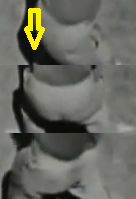 The first pic still is Jack Nicklaus at p4. The middle still is Nicklaus in transition and then the bottom still is Nicklaus at impact. I started to look at it from a left hip joint perspective. I can see Nicklaus’ top left hip joint ‘pull back’ from p4 to p7. And that’s what I wanted to do, ‘pull back the left hip joint’ in transition with Anterior Pelvic Tilt. The tough part for me right now is to do it and then remember to extend the left leg to power the club thru into impact and the follow thru. I tend to get a little Jackie Burke-ish where I don’t extend the left leg. 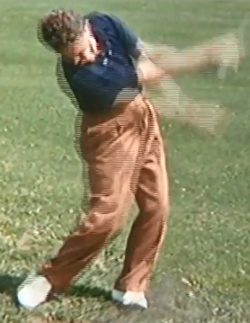 The difference is that my pelvis starts to stall when I do that while Mr. Burke could keep on rotating. The other tweak I’ve been experimenting with is the grip. I play with a very strong grip now because it doesn’t me. I get a little across the line at the top of the swing anyway, so the strong grip isn’t a detriment. I started to strengthen the left hand grip even more. Getting the heel pad more on top of the grip. A few weeks ago I was playing and felt this different sensation in my hands in the way I gripped the club right in the middle of my swing. I hit the drive and belted it about 330 yards down the middle. It felt like a much more powerful move thru the ball. And it was not until last night that I felt that sensation again and saw that the left hand got even a little stronger. And I started to hit some great shots that went straight as an arrow and really climbed in the air. What I like about the strong grip is that my brain starts to notice that the only way to make it work is to get rotation. Not enough rotation and the face will close and I’ll hit hooks. Too much slide and I might start hitting a shank, which I did a couple of times. I figure I can work on these two things along with sustaining the right shoulder ER for 3-4 weeks. Hopefully from there I will have them down pat and then I can send a video of my progress to Kelvin. |
|



